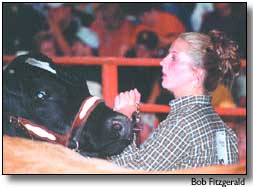|
||||
|
Aug. 4, 2001
By Janelle Holden If you’ve never been involved with a county fair’s steer show, it’s a bit hard to comprehend the idea of teenagers leading cows around a ring filled with sawdust for several hours. To the layman’s eye, the event looks like a livestock beauty pageant. Why else would someone rat a cow’s tail, form it into a ball, and then hairspray it for safe-keeping? Why else would cows be washed, combed, shined, and clipped with more precision than a hair-stylist cuts human hair? Why else would teenagers dress up in their best western clothing only to get large drool stains on the front of their shirts? The answer, according to the judge of the Montezuma County Fair beef show, is to promote character in young people.
"I certainly think this (4-H) is one of the most outstanding programs in the country" explained Milford Jenkins, the director of the development foundation at Oklahoma State University who was asked to judge both the beef and sheep at the fair. "Young people have the opportunity to join in a livestock program, buy these animals when they’re young, feed them until the time to show — which is the August county fair — during this process they’ve have an opportunity to develop a wonderful work ethic, build perseverance, and see that project through to completion." Jenkins told the crowd in the bleachers on Thursday evening that if more teenagers showed livestock and participated in 4-H and Future Farmers of America, there would be fewer shootings in American high schools. "I firmly believe that if more youth had the opportunity to show livestock, whether they be beef, whether they be swine, or whether they be sheep, and do all that 4-H offers them, we would not hear the horror stories that take place in our schools. We would not hear about Paducah, Kentucky, we would not hear about Jonesboro, Arkansas, we would not hear about Fort Gibbs, Oklahoma, and West Palm Beach, Florida, and more dear to your hearts, Columbine High School in Littleton, Colorado," said Jenkins to wild applause. When asked what he would be looking for during the steer show, Jenkins replied, "outstanding young men and women," who would like to earn "trophies of the heart." One of the competitors, Emilie Lanier, showed two steers in the steer show and also won grand prize in the cake-decorating contest. Lanier joined 4-H at the age of 8, and is currently president of the Pleasant View 4-H club, Kalvin’s Kids. "I always knew that I would be in it," said Lanier, who had several older siblings who participated in 4-H. Lanier, who recently graduated from Montezuma Cortez High School, has shown steers for four years at the fair, and sheep for six previous to that. Although Lanier’s two steers, Nile and Sunshine, placed lower in their weight classes this year, Lanier shrugged off her disappointment and said the judge had "good things to say" about her steers. "The fair is a lot of fun," explained Lanier. Lanier was chosen one of four top senior showmen. Showmen take little into the ring with them other than a nice halter, a scotch comb in the back pocket, and a show stick in the hand. Once steers stop walking, showmen "set them up" to look their best by moving their feet slightly with the show stick. Jenkins picked the best showman based on the showman’s ability to "accentuate the positives" and "de-emphasize the negatives," of the steer shown. It’s true that winning any prize at the fair takes some sweat of the brow, but raising a steer from birth and then teaching the over-1,000-pound animal to be led around like a puppy does have the ring of accomplishment. Lanier started training her steers to lead at the beginning of the summer. She will sell Nile, her heaviest steer, at the Junior Livestock Sale held tonight at 5:30. The steers sold at the livestock auction can sometimes sell for as much as seven times market value. An average steer in the state of Colorado sold for 66 cents a pound last August, but the grand-champion steer at the 2000 Montezuma County Fair cost $4.75 a pound. Out of the 43 steers shown on Thursday, Jenkins could only pick one grand champion. Jenkins’s reasons for picking the grand-champion steer, owned by Jeni DeFrenchie, had something to do with "straightness of line," "thickness of rump," "extra finish over the 12th rib" and "clean trim." "I think this steer would hang up the ideal carcass," he concluded. |
||||
|
Copyright © 2001 the Cortez Journal.
All rights reserved. |
